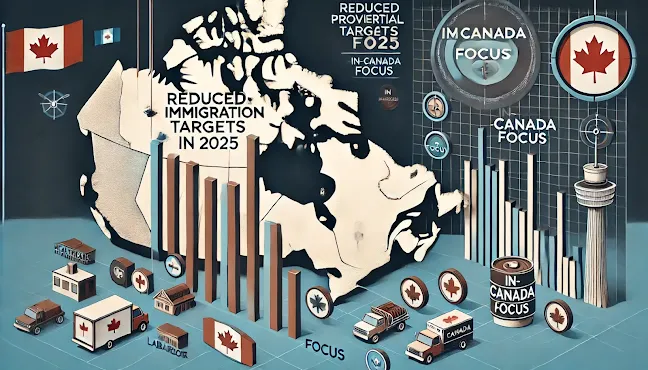PNPs Grapple with Slashed Provincial Immigration Targets
This development coincides with the postponed re-opening of the Northwest Territories Provincial Nominee Program (NTNP), which had planned to accept 100 applications for provincial nomination by January 16, 2025. The New Brunswick Provincial Nominee Program (NBPNP) has also announced adjustments to its 2025 provincial economic immigration programs in response to broader changes in Canada’s immigration system.
For prospective immigrants hoping to apply through a Provincial Nominee Program (PNP), delays in application intakes may become the norm as provinces adjust to these new realities. To date, only Manitoba has held a provincial immigration draw in 2025.
This article delves into the macro trends affecting provincial immigration activities and the outlook for 2025.
Provincial Immigration Targets Slashed
Under Canada’s annual Immigration Levels Plan, immigration targets for the upcoming year are finalized by November 1 of the previous year. However, the 2025-2027 Levels Plan introduced by Immigration Minister Marc Miller includes a 50% reduction in PNP admission allocations for 2025 compared to 2024. This dramatic shift has significant implications for provinces relying on PNPs to address labor shortages and drive economic growth.
Key Numbers
Year | Projected Provincial Immigration Targets | Actual Provincial Immigration Targets |
|---|---|---|
2024 | 110,000 | 110,000 |
2025 | 120,000 | 55,000 |
2026 | 55,000 |
Understanding Admissions: The term “admission” refers to the finalization of permanent resident status through a process known as “landing.” This involves an interview with an immigration officer, either at a Canadian port of entry or a local office, where the applicant’s confirmation of permanent residence (COPR) is signed. Admissions differ from Invitations to Apply (ITAs), which are issued earlier in the immigration process.
Counterweight to Reduced Targets: “In-Canada Focus” Category
In an effort to offset the reduced PNP targets, Immigration, Refugees and Citizenship Canada (IRCC) introduced the “In-Canada Focus” category under its federal immigration allocation. This category prioritizes:
Express Entry candidates under the Canadian Experience Class (CEC) program.
Candidates nominated through enhanced PNPs.
For 2025, the In-Canada Focus category has been allocated 82,890 admissions. While this initiative allows provincial governments to nominate more immigrants, it is unlikely to fully compensate for the sharp reduction in overall PNP targets.
Impacts on Provincial Immigration and Local Economies
Canada’s provinces rely on PNPs to address regional labor shortages and fill key roles in industries such as healthcare, construction, and technology. The halving of PNP admission targets in 2025 could create significant challenges, including:
Increased labor shortages: Sectors heavily reliant on skilled immigrants may struggle to meet demands.
Economic repercussions: Lower immigration levels could hinder growth in smaller communities and rural areas.
Provinces Respond
Provinces like Manitoba and Newfoundland and Labrador have called for higher immigration allocations to meet their economic and demographic needs. However, the federal government’s centralized control over immigration levels leaves provinces with limited recourse.
What This Means for Prospective Immigrants
While the reduced PNP targets may be discouraging, there are still pathways available for immigrants looking to settle in Canada. These include:
Express Entry: Candidates in the Canadian Experience Class or with provincial nominations through enhanced PNP streams may benefit from the In-Canada Focus category.
Other Federal Pathways: Programs like the Federal Skilled Worker Program (FSWP) and Federal Skilled Trades Program (FSTP) remain viable options.
Temporary Resident Programs: Work permits and study permits can provide alternative routes to permanent residency.
Practical Advice for Applicants
Stay Updated: Monitor announcements from IRCC and provincial governments for changes to PNPs and other immigration programs.
Explore Federal Options: If provincial pathways are limited, consider applying through federal programs like Express Entry.
Seek Professional Guidance: Immigration consultants and lawyers can help identify the best pathway based on your qualifications and goals.
Plan for Delays: Be prepared for longer processing times and limited intakes for certain programs.
Conclusion
The reduced PNP targets for 2025 mark a significant shift in Canada’s immigration strategy, with potential repercussions for provinces, industries, and prospective immigrants. While federal initiatives like the In-Canada Focus category offer some relief, they are unlikely to fully address the challenges posed by these cuts. For immigrants, staying informed and exploring alternative pathways will be key to navigating this new landscape.
For more information on Canada’s immigration programs, visit IRCC’s official website.





